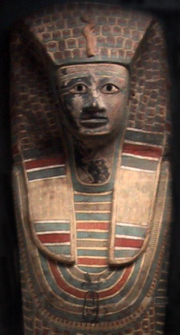
Intef VIII
Encyclopedia

Ancient Egypt
Ancient Egypt was an ancient civilization of Northeastern Africa, concentrated along the lower reaches of the Nile River in what is now the modern country of Egypt. Egyptian civilization coalesced around 3150 BC with the political unification of Upper and Lower Egypt under the first pharaoh...
king of the Seventeenth dynasty of Egypt
Seventeenth dynasty of Egypt
The Fifteenth, Sixteenth and Seventeenth Dynasties of ancient Egypt are often combined under the group title, Second Intermediate Period. The Seventeenth Dynasty dates approximately from 1580 to 1550 BC.-Rulers:...
, who ruled during the Second Intermediate Period, when Egypt was divided between the Theban based 17th Dynasty in Upper Egypt and the Hyksos 15th Dynasty who controlled Lower and part of Middle Egypt.
Sekhemre-Heruhirmaat Intef is referred to as Intef VII in some literature , while others refer to him as Intef VIII.
Sekhemre-Heruhirmaat Intef ruled from Thebes
Thebes, Egypt
Thebes is the Greek name for a city in Ancient Egypt located about 800 km south of the Mediterranean, on the east bank of the river Nile within the modern city of Luxor. The Theban Necropolis is situated nearby on the west bank of the Nile.-History:...
, and was buried in a tomb in the 17th Dynasty royal necropolis at Dra Abu El-Naga. His only clear attestation is his coffin—Louvre E 3020—now in France. His sarcophagus contained the corrected nomen of this king as well as his prenomen, Sekhemre Heruhirmaat, "which was added in ink on the chest of the coffin." Little more is known concerning the reign of this king except that he was a short-lived successor of Nebkheperre Antef VII. The Danish Egyptologist Kim Ryholt
Kim Ryholt
Kim S B Ryholt is a Danish Egyptologist, who works at the Carsten Niebuhr Institute of Near Eastern Studies at the University of Copenhagen....
has argued that Sekhemre-Heruhirmaat Intef was possibly a co-regent of Nebkheperre Antef VII based on a block from Koptos which preserves
Ryholt observes that the length of the damaged cartouche would fit well with the long prenomen of Antef VIII: Sekhemre Heruhirmaatre.
Brief Reign
Ryholt suggested that Sekhemre-Heruhirmaat Intef died prematurely and was buried in a royal coffin which initially belonged to Nebkheperre Antef VII; hence, Sekhemre-Heruhirmaat Intef did not enjoy an independent reign of his own. The British Egyptologist Aidan Dodson, however, critiques Ryholt's proposal that Sekhemre-Heruhirmaat Intef died during the reign of his predecessor and was buried in Sekhemre-Wepmaat Intef's original royal coffin. Dodson observes that the form of the name Antef written here (which was originally similar to that used to designate Nebkheperre Antef before it was amended for Heruhirmaatre Antef) and the added king's prenomen of Sekhemre Heruhirmaat on this king's coffin was composed in an entirely different hand from the remaining texts on the coffin. Dodson also stresses thatDodson's previous explanation derives from his GM 120 (1991) article where the author argues that Sekhemre-Heruhirmaat Intef was most probably a short-lived Theban king who died within months of his accession to power since the temple "scribes were probably still used to writing Inyotef in the manner of Nubkheperre [Intef] [sc. with the reed-leaf: in-it=f], leading to the corrected mistake on the coffin [of Sekhemre-Heruhirmaat Intef]".
This would also explain the modesty of Sekhemre-Heruhirmaat Intef's coffin which lacked a royal uraeus and is stylistically similar to the clearly non-royal coffin of Kamose
Kamose
Kamose was the last king of the Theban Seventeenth Dynasty. He was probably the son of Seqenenre Tao II and Ahhotep I and the full brother of Ahmose I, founder of the Eighteenth Dynasty. His reign fell at the very end of the Second Intermediate Period...
. Intef, hence, would not have had the time to create a proper royal coffin in his abbreviated reign.

